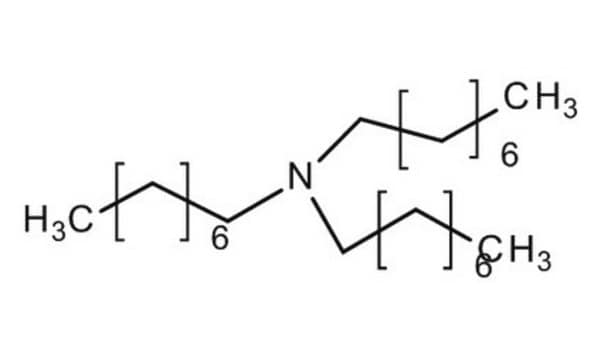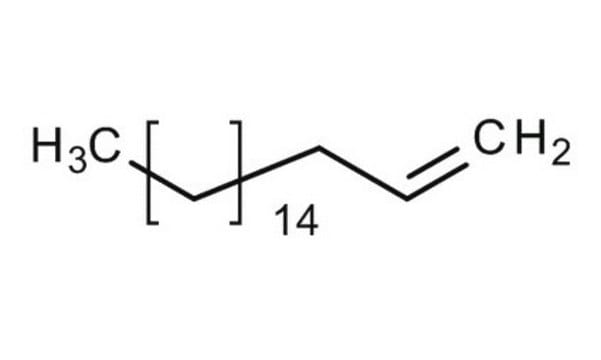If this product has an expiration or retest date, it will be shown on the Certificate of Analysis (COA, CofA). If there is no retest or expiration date listed on the product's COA, we do not have suitable stability data to determine a shelf life. For these products, the only date on the COA will be the release date; a retest, expiration, or use-by-date will not be displayed.
For all products, we recommend handling per defined conditions as printed in our product literature and website product descriptions. We recommend that products should be routinely inspected by customers to ensure they perform as expected.
For products without retest or expiration dates, our standard warranty of 1 year from the date of shipment is applicable.
For more information, please refer to the Product Dating Information document: https://www.sigmaaldrich.com/deepweb/assets/sigmaaldrich/marketing/global/documents/449/386/product-dating-information-mk.pdf
Wichtige Dokumente
O7805
Oleylamin
technical grade, 70%
Synonym(e):
cis-1-Amino-9-octadecen, cis-1-Amino-9-octadecen
Größe auswählen
About This Item
Empfohlene Produkte
Qualität
technical grade
Qualitätsniveau
Dampfdruck
8 mmHg ( 135 °C)
Assay
70%
Zusammensetzung
primary amine, >98%
Brechungsindex
n20/D 1.4596 (lit.)
bp
348-350 °C (lit.)
mp (Schmelzpunkt)
18-26 °C (lit.)
Dichte
0.813 g/mL at 25 °C (lit.)
SMILES String
[H]\C(CCCCCCCC)=C(/[H])CCCCCCCCN
InChI
1S/C18H37N/c1-2-3-4-5-6-7-8-9-10-11-12-13-14-15-16-17-18-19/h9-10H,2-8,11-19H2,1H3/b10-9-
InChIKey
QGLWBTPVKHMVHM-KTKRTIGZSA-N
Suchen Sie nach ähnlichen Produkten? Aufrufen Leitfaden zum Produktvergleich
Allgemeine Beschreibung
Signalwort
Danger
Gefahreneinstufungen
Acute Tox. 4 Oral - Aquatic Acute 1 - Aquatic Chronic 1 - Asp. Tox. 1 - Eye Dam. 1 - Skin Corr. 1B - STOT RE 2 - STOT SE 3
Zielorgane
Respiratory system
Lagerklassenschlüssel
8A - Combustible corrosive hazardous materials
WGK
WGK 3
Flammpunkt (°F)
309.2 °F - closed cup
Flammpunkt (°C)
154 °C - closed cup
Persönliche Schutzausrüstung
Eyeshields, Faceshields, Gloves, type P3 (EN 143) respirator cartridges
Hier finden Sie alle aktuellen Versionen:
Besitzen Sie dieses Produkt bereits?
In der Dokumentenbibliothek finden Sie die Dokumentation zu den Produkten, die Sie kürzlich erworben haben.
Kunden haben sich ebenfalls angesehen
Artikel
Solvothermal synthesis of nanoparticles: applications from nanocircuits and nano-optical circuits to nanomagnetics and biotech.
Prof. Randal Lee discusses iron oxide magnetic nanospheres and nanocubes design considerations for biosensing applications.
Magnetic nanoparticles have attracted tremendous attention due to their novel properties and their potential applications in magnetic recording, magnetic energy storage and biomedicine.
-
How can I determine the shelf life / expiration / retest date of this product?
1 Antwort-
Hilfreich?
-
-
How is shipping temperature determined? And how is it related to the product storage temperature?
1 Antwort-
Products may be shipped at a different temperature than the recommended long-term storage temperature. If the product quality is sensitive to short-term exposure to conditions other than the recommended long-term storage, it will be shipped on wet or dry-ice. If the product quality is NOT affected by short-term exposure to conditions other than the recommended long-term storage, it will be shipped at ambient temperature. As shipping routes are configured for minimum transit times, shipping at ambient temperature helps control shipping costs for our customers. For more information, please refer to the Storage and Transport Conditions document: https://www.sigmaaldrich.com/deepweb/assets/sigmaaldrich/marketing/global/documents/316/622/storage-transport-conditions-mk.pdf
Hilfreich?
-
-
is it fine to store Oleylamine in plastic vials? Does it reacts with plastic or rubber cork present in the glass vials cap?
1 Antwort-
This product is packaged in amber glass bottles and polypropylene screw caps with EPDM/PTFE liners. Compatibility testing with plastics and/or rubber corks has not been performed. Generally, plastic vials and rubber corks are chemically inert and often nonreactive with most chemicals. However, leaching or degradation cannot be ruled out. It is recommended that this material be stored in the original or similar containers to preserve the quality of the compound.
Hilfreich?
-
-
Is the O7805 Oleylamine technical grade 70% considered contaminated if the bottle arrived very cloudy?
1 Antwort-
The material has a melting point between 18 °C and 26 °C, and it is normal for the product to become cloudy or precipitate in cold temperatures. The product is specified as a clear to hazy liquid, and gentle heating can be applied to restore its clarity
Hilfreich?
-
Aktive Filter
Unser Team von Wissenschaftlern verfügt über Erfahrung in allen Forschungsbereichen einschließlich Life Science, Materialwissenschaften, chemischer Synthese, Chromatographie, Analytik und vielen mehr..
Setzen Sie sich mit dem technischen Dienst in Verbindung.















